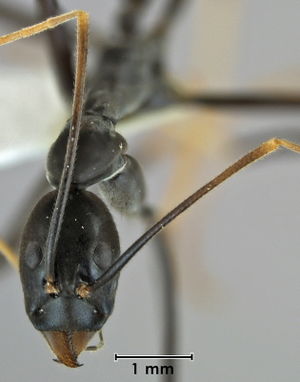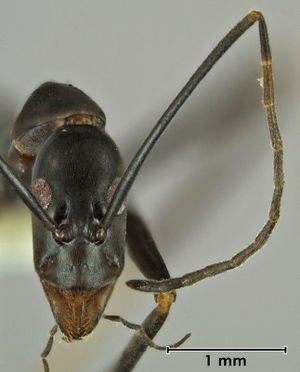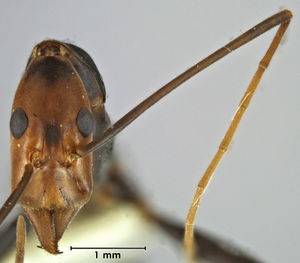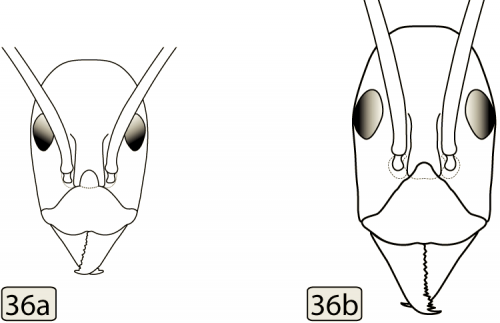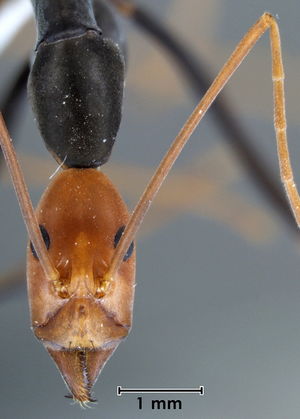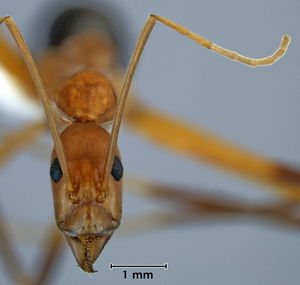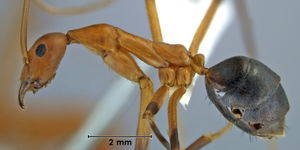Key to Australian Leptomyrmex Species
The following key to Australian Leptomyrmex species has been modified from Smith & Shattuck (2009[1]) and Lucky & Ward (2010[2]).
1
- Body larger (head width > 0.80mm) and often with bright orange colouration (but sometimes uniform brown to black) => 2
- Body smaller (head width < 0.80mm) and always yellow-brown to brown => 14
2
- Pubescence, in the form of decumbent to suberect pilosity, conspicuous and common on eyes, head and pronotum (Fig. 26a); unicolorous black; larger species (HW 1.37–1.51 mm), with broad head (CI 0.72–0.80); NE QLD. => Leptomyrmex unicolor
- Pubescence inconspicuous, consisting of very fine, short, appressed hairs; eyes hairless (Fig. 26b); coloration and size variable (HW 0.82–1.96 mm, CI 0.53–0.79); ACT, NSW, QLD, VIC. => 3
3
- Small, slender species (HL 1.40–1.72 mm, HW 0.82–1.03 mm, CI 0.56–0.62) (Fig. 27a0; postocular portion of head rounded, without necklike constriction; QLD. => 4
- Generally larger species (HL 1.65–2.63 mm, HW 1.04–1.96 mm, CI 0.53–0.79) (Fig. 27b); if HL < 1.72 mm (i.e. some workers of Leptomyrmex wiburdi, NSW), then head broader (CI 0.65–0.70); postocular portion of head rounded or with necklike constriction; ACT, NSW, QLD, VIC. => 5
4
- Very small species (HL 1.40–1.53 mm, HW 0.82–0.87 mm); unicolorous black with large eyes and compressed, scale-like petiole (Fig. 28a); QLD. => Leptomyrmex mjobergi
- Relatively larger species (HL 1.60–1.72 mm, HW 0.94–1.03 mm); head and often mesosoma rufotestaceous, with medium sized eyes, petiole node-like (Fig. 28b); restricted to Cape York, QLD. => Leptomyrmex darlingtoni
5
- Posterior margin of head narrowing to a necklike constriction, head slender and elongate (CI 0.53–0.64) (Fig. 29a, b) => 6
- Head lacking necklike constriction, i.e. postocular margin rounded, and margins of head posterior to eyes broadly convex† (Fig. 29c,d), head broad to moderately elongate (CI 0.59–0.79) => 9
Note: Some workers of Leptomyrmex varians will key out to couplet 13 if the postocular portion of the head is considered rounded rather than necklike (couplet 5). For specimens from central QLD approximately matching the color pattern of Leptomyrmex cnemidatus, but with tibiae and femora entirely dark, and with head very narrow (CI 0.53–0.59), follow couplet 5a.
6
- Head and tarsi testaceous, otherwise entirely black (Fig. 30a); NE QLD. => Leptomyrmex ruficeps
- Mesosoma partially or fully rufotestaceous, or mottled; tarsi testaceous; femora often dark distally (Fig. 30b); NSW, QLD. => 7
7
- Pronotum and head dark and mottled (Fig. 31a), sometimes dark patches extending further onto mesosoma; necklike constriction exaggerated and distinctly flattened (Fig. 29a); tibiae pale; SE QLD. => Leptomyrmex rothneyi
- Mesosoma and head rufotestaceous, if dark spots present, confined to discrete patches on pronotum and forecoxae (Fig. 31b); necklike constriction either exaggerated or slight (Figs 29a); tibiae pale or dark; QLD, N. NSW. => 8
8
- Tibiae pale; if femur dark, at least proximal ¼ pale; scapes relatively short (SI 2.75–3.35), surpassing posterior margin by less than 3/5 of their length; eyes not surpassing lateral margins of head (Fig. 32a); QLD, NE NSW. => Leptomyrmex rufipes
- Tibiae and femora dark; scapes long (SI 3.31–3.82) surpassing posterior margin by approx. 2/3 of their length; eyes surpassing lateral margins of head (Fig. 32b); Central QLD. => Leptomyrmex varians
9
- Ten or more standing hairs on posterior face of hind tibia (Fig. 33a); erect pilosity more abundant on body; very large species (HL 2.27–2.63 mm, HW 1.49–1.96 mm) with broad head (CI 0.66–0.79), (Fig. 33b) => 10
- Zero to five standing hairs on posterior face of hind tibia (Fig. 33c); erect pilosity less abundant on body; small to large species (HL 1.65–2.41 mm, HW 1.15–1.56 mm) generally with less broad head (CI 0.59–0.66) (Fig. 33d); species with broad head (e.g. some workers of Leptomyrmex wiburdi, CI 0.66–0.70) are much smaller (HL 1.65–1.94 mm, HW 1.15–1.33 mm) => 11
10
- Tibiae rufotestaceous (Fig. 34a), less compressed (HTC 0.52–0.66); NSW. => Leptomyrmex nigriventris
- Tibiae dark (Fig. 34b), more compressed (HTC 0.34–0.49); SE QLD, NE NSW. => Leptomyrmex tibialis
11
- Coxae black (Fig. 35a), head rufotestaceous, not black or mottled, mesosoma rufotestaceous; head broad (CI 0.61–0.66), tibiae only moderately compressed, their widths < MFC; SE QLD. => Leptomyrmex rufithorax
- Coxae variable, but if dark, then most of mesosoma dark also (Figs 35b, 35c); head narrow to broad (CI 0.59–0.70); head rufotestaceous, black or mottled; tibiae compressed or not, their widths greater than, equal to or less than MFC; mesosoma rufotestaceous, black or mottled; ACT, NSW, QLD, VIC. => 12
12
- Small species (HL 1.65–1.94 mm, HW 1.15–1.33 mm) with broad head (CI 0.66–0.70); head reaching maximal width posterior to eyes (Fig. 36a); postocular portion of head short and broadly rounded; eyes large; antennal scapes relatively short (SI 2.29–2.64), surpassing posterior margin of head by less than 2/3 their length; hind tibiae short (HTL 3.32–3.88); color pattern extremely variable; NSW. => Leptomyrmex wiburdi
- Generally larger species with less broad head (CI 0.59–0.63), reaching maximum width at eye level (Fig. 36b); postocular portion of head usually more elongate and less broadly rounded; antennal scapes longer (SI 2.87–3.20), surpassing posterior margin of head by approximately 3/5 their length; hind tibiae long (HTL 4.44–5.38 mm); color pattern usually matching the dominant forms described in couplet 13. => 13
13
- Larger species, on average (HL 2.17–2.41 mm; HW 1.31–1.47 mm); typical color pattern consisting of black body with contrasting rufotestaceous head (Fig. 37a), but in northern half of range some individuals with black head and variable amounts of rufotestaceous color on mesosoma; in areas of sympatry with Leptomyrmex cnemidatus (Sydney region) central portion of clypeus, excluding the anterior margin, with 0–2 black setae: if 2 setae then these separated by 0.25 mm or more; ACT, VIC, NSW, SE QLD. => Leptomyrmex erythrocephalus
- Smaller species on average (HL 1.99–2.29 mm; HW 1.20–1.39 mm); typical color pattern consisting of rufotestaceous head and mesosoma, with gaster, tibiae, and distal portions of femora black*† (Fig. 37b); in area of sympatry with Leptomyrmex erythrocephalus (Sydney region) central portion of clypeus, excluding the anterior margin, with 2–4 black setae (sometimes abraded, look for black setal base): if only two setae, then these separated by less than 0.25 mm; NSW, SE QLD. => Leptomyrmex cnemidatus
Note: Some workers of Leptomyrmex varians will key out to couplet 13 if the postocular portion of the head is considered rounded rather than necklike (couplet 5). For specimens from central QLD approximately matching the color pattern of Leptomyrmex cnemidatus, but with tibiae and femora entirely dark, and with head very narrow (CI 0.53–0.59), follow couplet 5a.
14
- Scapes short (scape length < 1.1 mm, SI < 150, Fig. 20); head short (CI > 82, Fig. 19); hind tibial spurs with barbules approximately as long as spur diameter => Leptomyrmex ramorniensis
- Scapes long (scape length > 1.0 mm, SI > 170, Fig. 20); head long (CI < 81, Fig. 19); hind tibial spurs with barbules approximately half as long as spur diameter => 15
15
- Pubescence long, dense and decumbent => Leptomyrmex pilosus
- Pubescence short, sparse and adpressed => 16
16
- Petiolar node flat dorsally in anterior view => Leptomyrmex aitchisoni
- Petiolar node convex dorsally in anterior view => 17
17
- Antennal scapes relatively long (SI > 220, Fig. 20), extending beyond vertex by more than half their length => Leptomyrmex dolichoscapus
- Antennal scapes relatively short (SI < 220, Fig. 20), extending beyond vertex by about half their length => 18
18
- Anterior mesonotum raised into a bump, dorsum of node highly and uniformly convex in anterior view => Leptomyrmex burwelli
- Anterior mesonotum without a raised bump, dorsum of node weakly convex in anterior view, the sides more strongly curved than the central region => Leptomyrmex garretti
